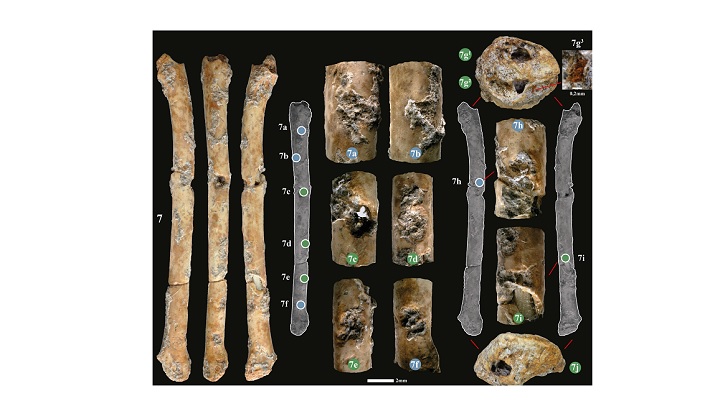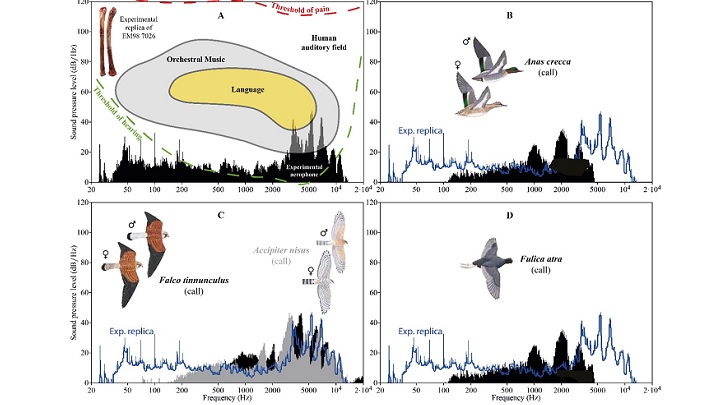Exceptional findings of seven prehistoric sound instruments

12,000 years ago, Palaeolithic populations turned the bones of small birds into instruments that imitated the song of certain birds. Prehistorians, however, have been able to document very few remains of these objects, forerunners of today's whistles or flutes. Now, a study published in Scientific Reports explains the exceptional discovery of seven of these instruments at a site in northern Israel. The authors of the study explain that Palaeolithic communities could use the sound of these objects to communicate, attract preys when hunting, or even to make music.

12,000 years ago, Palaeolithic populations turned the bones of small birds into instruments that imitated the song of certain birds. Prehistorians, however, have been able to document very few remains of these objects, forerunners of today's whistles or flutes. Now, a study published in Scientific Reports explains the exceptional discovery of seven of these instruments at a site in northern Israel. The authors of the study explain that Palaeolithic communities could use the sound of these objects to communicate, attract preys when hunting, or even to make music.
The study has been carried out by an international team of archaeologists and ethnomusicologists led by José Miguel Tejero, Ramón y Cajal researcher at the Prehistoric Studies and Research Seminar (SERP) of the University of Barcelona and the Laboratory of Paleogenetics of the University of Vienna, and Laurent Davin, from the French National Centre for Scientific Research (CNRS). The objects they discovered come from the archaeological site of Eynan (Ain Mallaha), in northern Israel, which belongs to the Late Natufian archaeological period or culture (c. 13,000-99,700 BC), excavated since 1955 by a Franco-Israeli team.
Eynan is a late Palaeolithic settlement of small stone-plinth dwellings near Lake Hula in the Jordan Valley. Just over 12,000 years ago, the settlement was home to one of the last groups of hunter-gatherers in the Near East. The sound instruments discovered on the floor inside some of the room structures and their immediate surroundings correspond to seven aerophones made from the wing bones (ulna, radius, humerus) of two species of water birds: the common teal (Anas crecca) and the common coot (Fulica atra).
The traceology, the taphonomy, and the technological, experimental and acoustic analyses have shown that these prehistoric tools were made to imitate the song or the sound of two species of birds of prey: the common kestrel (Falco tinnunculus), and the common sparrowhawk (Accipiter). There was without any doubt a particular relationship between the Eynan people and these birds of prey: it is known that they sometimes hunted them specifically to use their claws (terminal phalanges) for symbolic purposes, probably as ornaments.
The discovery, now published, is important because there is a limited number of prehistoric instruments that have survived to the present day. Moreover, the previous finds were made in archaeological campaigns in the first half of the last century, without the current scientific standards.
This discovery provides valuable new data on the antiquity and development of prehistoric sound instruments in general, and more specifically on the Natufian archaeological culture, at the dawn of the domestication of plants and animals in the Levant of the Near East, leading to the new forms of production that we call the Neolithic. Never before had prehistoric sound instruments been documented in the Near East.
Future studies on this set of instruments could focus, among other aspects, on trying to identify more precisely their function(s) (ethnomusicology), as well as the perception and effect of sounds produced by humans and other animals (psychoacoustics). Finally, this study will make it possible to make new discoveries about this type of object by re-examining collections of bird bones from other archaeological sites in the Near East and other geographical regions, and to promote research into archaeoacoustics.
Multimedia gallery

Graphs of the human auditory field.
Spectral analysis of the sounds produced by the experimental replica of the bonein the complete aerophone (A). It can be compared with the call of the Eurasian teal (B); the songs of the common kestrel and the sparrowhawk (C); and the call of the Eurasian coot (D).

